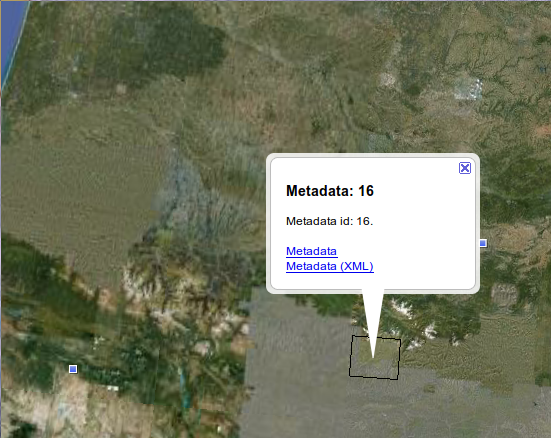Note: Warning: Using this, all metadata record's bounding box will be visible to all. Spatial index contains all metadata records (including templates) and the WMS will not take care of filtering bounding box according to privileges.
How-to browse your GeoNetwork spatial index using WMS in GeoServer ?
Create a link between spatial index directory to GeoServer data directory
cd trunk/data/geoserver_data/data ln -s ../../../web/geonetwork/WEB-INF/lucene/spatial/ spatialindex
Note: Occasionally a lock issue on the Shapefile occurs when both GeoNetwork and GeoServer try to access the file. This causes Geoserver to lose the configuration for the shapefile. A better option could be to make a copy of the files on a regular basis or use Geoserver's RESTful interface
UPDATE: If your using geoserver 2.x and you cant get it to detect the shape file or shapefile directory - leave data/ out from the paths shown in the screen shots.
Configure GeoServer to deploy the spatial index Shapefile
Really simple SLD style
<?xml version="1.0" encoding="ISO-8859-1"?>
<StyledLayerDescriptor version="1.0.0" xmlns="http://www.opengis.net/sld" xmlns:ogc="http://www.opengis.net/ogc"
xmlns:xlink="http://www.w3.org/1999/xlink" xmlns:xsi="http://www.w3.org/2001/XMLSchema-instance"
xsi:schemaLocation="http://www.opengis.net/sld http://schemas.opengis.net/sld/1.0.0/StyledLayerDescriptor.xsd">
<NamedLayer>
<Name>Catalogue bounding box style</Name>
<UserStyle>
<Title>Catalogue</Title>
<Abstract></Abstract>
<FeatureTypeStyle>
<Rule>
<Title>Polygon</Title>
<PolygonSymbolizer>
<Stroke>
<CssParameter name="stroke">#000000</CssParameter>
<CssParameter name="stroke-width">3</CssParameter>
</Stroke>
</PolygonSymbolizer>
<TextSymbolizer>
<Label>
<ogc:PropertyName>id</ogc:PropertyName>
</Label>
<Font>
<CssParameter name="font-family">Times New Roman</CssParameter>
<CssParameter name="font-style">Normal</CssParameter>
<CssParameter name="font-size">14</CssParameter>
</Font>
<LabelPlacement>
<PointPlacement>
<AnchorPoint>
<AnchorPointX>0.5</AnchorPointX>
<AnchorPointY>0.5</AnchorPointY>
</AnchorPoint>
</PointPlacement>
</LabelPlacement>
</TextSymbolizer>
</Rule>
</FeatureTypeStyle>
</UserStyle>
</NamedLayer>
</StyledLayerDescriptor>
Access the WMS using a WMS client (eg. OpenLayers, GoogleEarth)
OpenLayers
GoogleEarth
You could use GeoServer KML templating system in order to style your KML. On issue will be that only the metadata record ID (internal GeoNetwork identifier) is available.
KML Demo template:
- title
Metadata: ${id.value} - description
Metadata id: ${id.value}. <br/> <br> <a href="http://localhost:8080/geonetwork/srv/en/metadata.show?id=${id.value}">Metadata</a><br/> <a href="http://localhost:8080/geonetwork/srv/en/xml.metadata.get?id=${id.value}">Metadata (XML)</a>
Note: Here the privilege filter is applied by the catalogue.
Comments
- Another option at least for KML output (not WMS) is to create a searcher which output KML (Done in geocat.ch sandbox on top of a CSW searcher).
- In order to retrieve more information from the shapefile using Talend ETL could be an option to create a more complete shapefile with metadata title, change date, ...
See http://www.talendforge.org/wiki/doku.php?id=sdi:geonetworkmetadataextractfields
Attachments (5)
-
1-datastore.png
(13.9 KB
) - added by 15 years ago.
Datastore configuration
-
2-set-shapefile.png
(24.6 KB
) - added by 15 years ago.
Define shapefile to use
-
3-feature-type.png
(52.6 KB
) - added by 15 years ago.
Configure feature type
-
4-googleearth.png
(312.8 KB
) - added by 15 years ago.
Google Earth output
-
4-openlayers.png
(12.8 KB
) - added by 15 years ago.
OpenLayers output
Download all attachments as: .zip





